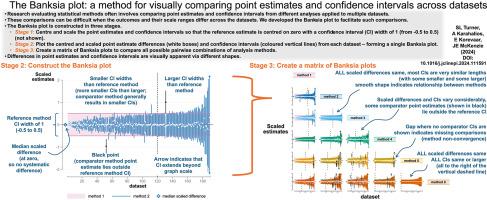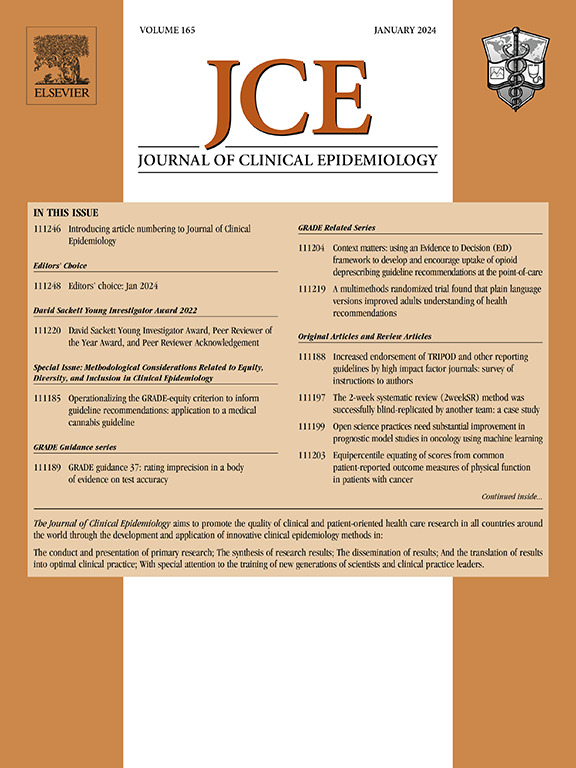银行图:一种直观比较不同数据集的点估计值和置信区间的方法。
IF 7.3
2区 医学
Q1 HEALTH CARE SCIENCES & SERVICES
引用次数: 0
摘要
目的:在评估统计分析方法的研究中,一个共同的目标是比较不同分析计算出的点估计值和置信区间 (CI)。当不同数据集的结果(及其规模范围)不同时,这项工作就很有挑战性。因此,我们开发了一种图形方法--"Banksia 图",通过绘制和比较数据集内和数据集间每种分析方法的点估计值和置信区间,促进不同统计分析方法的配对比较:研究设计和设置:该图谱分三个阶段绘制。第一阶段:为了比较两种统计分析方法的结果,在每个数据集上,参考分析方法的点估计值以零为中心,其置信区间按比例调整为-0.5 至 0.5。然后对相应的参照分析点估算值和置信区间应用相同的居中和比例调整值。第 2 阶段:在以零为中心、范围为-0.5 至 0.5 的矩形上绘制每个数据集的参照方法的定中心和缩放点估计值,从而绘制班克斯图,该矩形代表参照方法的结果。第 3 阶段:可选择绘制银行图矩阵,显示多种分析方法的所有成对比较结果。我们用两个例子来说明班克斯图:结果:对班克西亚图的说明表明,当使用不同的分析方法(例 1)或不同的数据提取器(例 2)时,该图可立即显示点估计值和置信区间是否存在差异。此外,我们还演示了如何使用不同的置信区间排序基础来突出特定差异(即点估计值或置信区间宽度):Banksia图为不同分析方法的成对比较提供了直观的总结,可以轻松识别点估计值和置信区间的模式和趋势。本文章由计算机程序翻译,如有差异,请以英文原文为准。

The Banksia plot: a method for visually comparing point estimates and confidence intervals across datasets
Objectives
In research evaluating statistical analysis methods, a common aim is to compare point estimates and CIs calculated from different analyses. This can be challenging when the outcomes (and their scale ranges) differ across datasets. We therefore developed a graphical method, the “Banksia plot”, to facilitate pairwise comparisons of different statistical analysis methods by plotting and comparing point estimates and CIs from each analysis method, both within and across datasets.
Study Design and Setting
The plot is constructed in three stages. Stage 1: To compare the results of two statistical analysis methods, for each dataset, the point estimate from the reference analysis method is centered on zero, and its confidence limits are scaled to range from −0.5 to 0.5. The same centering and scale adjustment values are then applied to the corresponding comparator analysis point estimate and confidence limits. Stage 2: A Banksia plot is constructed by plotting the centered and scaled point estimates from the comparator method for each dataset on a rectangle centered at zero, ranging from −0.5 to 0.5, which represents the reference method results. Stage 3: Optionally, a matrix of Banksia plots is graphed, showing all pairwise comparisons from multiple analysis methods. We illustrate the Banksia plot using two examples.
Results
Illustration of the Banksia plot demonstrates how the plot makes it immediately apparent whether there are differences in point estimates and CIs when using different analysis methods (example 1) or different data extractors (example 2). Furthermore, we demonstrate how different bases for ordering the CIs can be used to highlight particular differences (ie, in point estimates or CI widths).
Conclusion
The Banksia plot provides a visual summary of pairwise comparisons of different analysis methods, allowing patterns and trends in the point estimates and CIs to be easily identified.
求助全文
通过发布文献求助,成功后即可免费获取论文全文。
去求助
来源期刊

Journal of Clinical Epidemiology
医学-公共卫生、环境卫生与职业卫生
CiteScore
12.00
自引率
6.90%
发文量
320
审稿时长
44 days
期刊介绍:
The Journal of Clinical Epidemiology strives to enhance the quality of clinical and patient-oriented healthcare research by advancing and applying innovative methods in conducting, presenting, synthesizing, disseminating, and translating research results into optimal clinical practice. Special emphasis is placed on training new generations of scientists and clinical practice leaders.
 求助内容:
求助内容: 应助结果提醒方式:
应助结果提醒方式:


